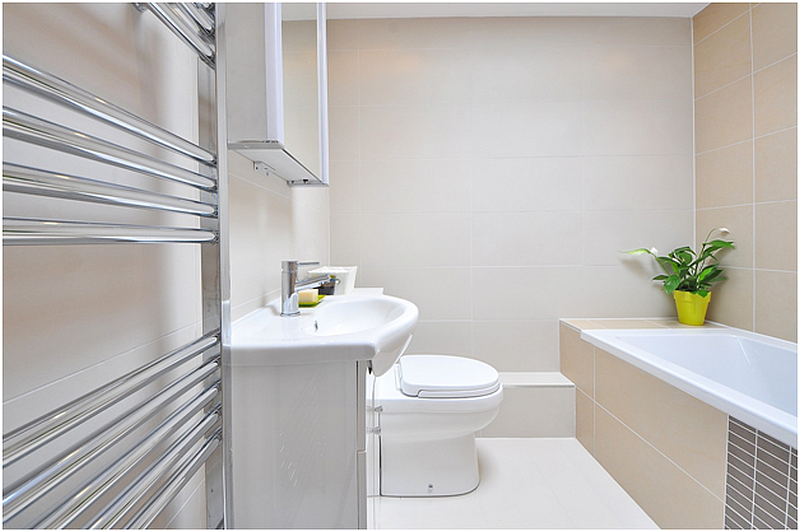Eco-friendly bathroom remodeling is more than just a trend; it’s an essential step toward creating a healthier and more sustainable home. By focusing on sustainable practices, you not only help protect the environment but also enhance your bathroom’s functionality and aesthetics. In Austin, a city known for its commitment to green living, incorporating eco-friendly elements into your bathroom remodel can align with local values and potentially increase your home’s appeal. This guide offers practical tips on integrating recycled materials, low-VOC paints, and natural resources into your remodel, ensuring your bathroom is both stylish and sustainable.
1. Embrace Recycled and Reclaimed Materials
Using recycled and reclaimed materials is a great way to make your bathroom remodel more sustainable. Materials like recycled glass tiles, reclaimed wood, and repurposed metals not only reduce waste but also add a unique, personalized touch to your space.
Recycled glass tiles can serve as a striking feature in your bathroom. They come in various colors and finishes, allowing you to create eye-catching designs while minimizing the use of new raw materials. Reclaimed wood, whether used for countertops or shelving, brings warmth and character to your bathroom. It’s a great way to incorporate a piece of history into your design.
When selecting these materials, consider their origin and the environmental impact of their production. Local suppliers often offer a range of eco-friendly options and can provide information on the materials’ sustainability. By choosing materials with a lower environmental footprint, you contribute to a greener remodeling project.
2. Showers and Shower Replacement
When planning a shower replacement in Austin, prioritize water efficiency without sacrificing style. Modern showers offer a range of options that combine performance with sustainability. Choose water-saving showerheads with flow rates of 2.0 gallons per minute or less. These fixtures reduce water consumption while providing a satisfying shower experience.
Consider also upgrading to a shower system designed to enhance water efficiency. Look for options that include temperature control and flow restrictors to reduce water waste further. If you’re working with a contractor, discuss eco-friendly shower options to ensure you choose a system that aligns with your sustainability goals.
In Austin, where green living is a significant aspect of the community, selecting local suppliers and installers who specialize in eco-friendly products can provide additional benefits. They can offer guidance on the best practices and products for your shower replacement, ensuring both efficiency and style.
3. Choose Low-VOC and Non-Toxic Paints
Paint plays a significant role in indoor air quality. Traditional paints often contain volatile organic compounds (VOCs) that can contribute to respiratory issues and environmental harm. Opting for low-VOC and non-toxic paints helps create a healthier bathroom environment.
Low-VOC paints have reduced levels of harmful chemicals, making them a better choice for indoor air quality. They come in various colors and finishes, allowing you to achieve your desired aesthetic without compromising health. Non-toxic paints go a step further, containing no hazardous substances, which is ideal for creating a safe environment for all household members.
When selecting paint, look for products with certifications from reputable organizations. These certifications indicate that the paint meets specific environmental and health standards. Following the manufacturer’s application instructions will ensure a smooth and durable finish.
4. Incorporate Natural and Sustainable Materials
Natural and sustainable materials can elevate the aesthetic of your bathroom while supporting eco-friendly practices. Bamboo, cork, and natural stone are excellent choices for flooring, countertops, and cabinetry.
Bamboo is a rapidly renewable resource that’s both durable and stylish. It works well for flooring and cabinetry, offering a modern look with minimal environmental impact. Cork, another sustainable option, is harvested from the bark of cork oak trees, making it a renewable material with natural insulating properties.
Natural stone, such as granite or marble, provides a timeless look and is long-lasting. However, ensure that the stone is sourced responsibly to support sustainable quarrying practices. Combining these materials in your design can create a cohesive and attractive bathroom that aligns with your commitment to sustainability.
By thoughtfully incorporating recycled materials, low-VOC paints, and natural resources, you can achieve a bathroom remodel that is both eco-friendly and aesthetically pleasing. This approach not only benefits the environment but also enhances the overall quality and appeal of your space.
5. Creative Cabinetry Design
Cabinetry is a significant aspect of bathroom design and offers numerous opportunities for sustainable choices. Opting for sustainable materials like bamboo or FSC-certified wood can make a big difference. Bamboo is a rapidly renewable resource that is durable and has a sleek, modern appearance. FSC-certified wood ensures that the material comes from responsibly managed forests, promoting sustainable forestry practices.
When designing your cabinetry, consider finishes that are low in toxins. Water-based or zero-VOC finishes are ideal, as they reduce indoor air pollution and are safer for your health. Creative cabinetry designs can maximize functionality and space efficiency. Think about incorporating built-in organizers, pull-out shelves, and customizable storage solutions. These features not only enhance the usability of your space but also reduce the need for additional furniture, supporting a minimalist and sustainable approach.
By integrating eco-friendly materials and innovative designs, you can create cabinetry that is both stylish and environmentally responsible. Custom cabinetry can reflect your personal style while adhering to sustainable practices, ensuring that your bathroom remodel is both functional and beautiful.
6. Color Palettes and Eco-Friendly Paints
Choosing the right color palette can significantly impact the overall feel of your bathroom while maintaining sustainability. Opt for colors that complement natural materials and create a serene, inviting atmosphere. Earthy tones like soft greens, blues, and neutral shades often work well with sustainable materials and promote a calming environment.
Low-VOC and non-toxic paints are essential for maintaining indoor air quality. These paints come in a wide range of colors, allowing you to achieve your desired look without compromising health. When selecting a color palette, consider how the colors will interact with natural light and the materials used in your remodel. Lighter shades can make a small bathroom feel larger, while darker hues add depth and coziness.
It’s also helpful to test paint samples on your walls before making a final decision. It ensures that the colors look as expected in different lighting conditions and match well with your chosen materials.
7. Accents and Textures
Incorporating accents and textures adds visual interest and depth to your bathroom while staying eco-friendly. Recycled glass tiles, reclaimed wood, and natural stone can all serve as stylish, sustainable accents. These materials not only enhance the aesthetic appeal but also support your commitment to sustainability.
Textures play a crucial role in creating a dynamic and inviting space. Consider adding textured elements like woven baskets, bamboo rugs, or cork wall panels. These textures can add warmth and character to your bathroom while using materials that are both sustainable and visually appealing.
When selecting accents, choose items that complement your overall design and contribute to a cohesive look. Avoid excessive decoration that could lead to clutter; instead, focus on a few well-chosen pieces that enhance the space while adhering to eco-friendly principles.
8. Maximize Recycling and Waste Reduction
Effective recycling and waste reduction are vital for a sustainable remodel. During the renovation process, salvage and reuse existing fixtures and materials whenever possible. This approach not only reduces waste but also can save money and preserve valuable resources.
Implement a recycling plan for construction debris, separating materials like wood, metal, and glass for proper disposal. Look for local recycling centers or programs that accept construction waste. By minimizing the amount of waste that ends up in landfills, you support a more sustainable remodeling process.
Additionally, consider donating unwanted fixtures and materials to local charities or resale shops. This practice helps others while contributing to waste reduction and sustainability.
Conclusion
Incorporating sustainable practices into your bathroom remodel can lead to a healthier home and a positive environmental impact. By focusing on creative cabinetry design, choosing eco-friendly paints and colors, adding sustainable accents, and maximizing recycling efforts, you can create a stylish and responsible bathroom. Austin’s eco-conscious market provides ample opportunities to explore and implement these sustainable choices, ensuring that your remodel aligns with both your personal values and community standards. With thoughtful planning and a commitment to sustainability, your bathroom can be both beautiful and environmentally friendly.
Article Submitted By Community Writer




